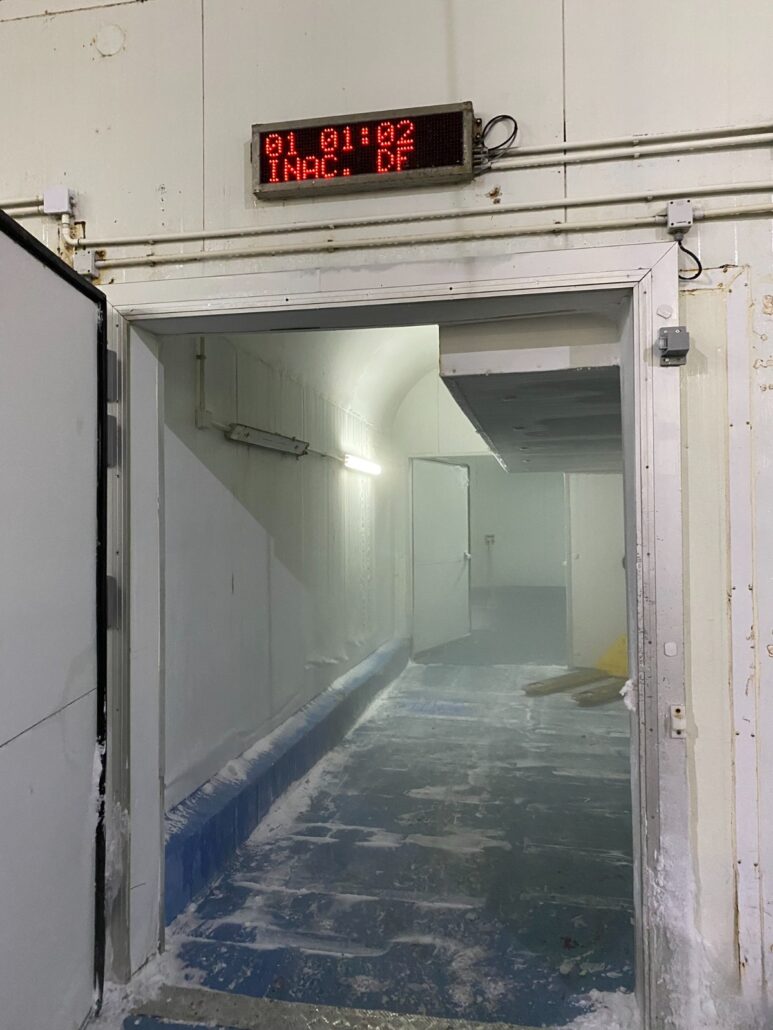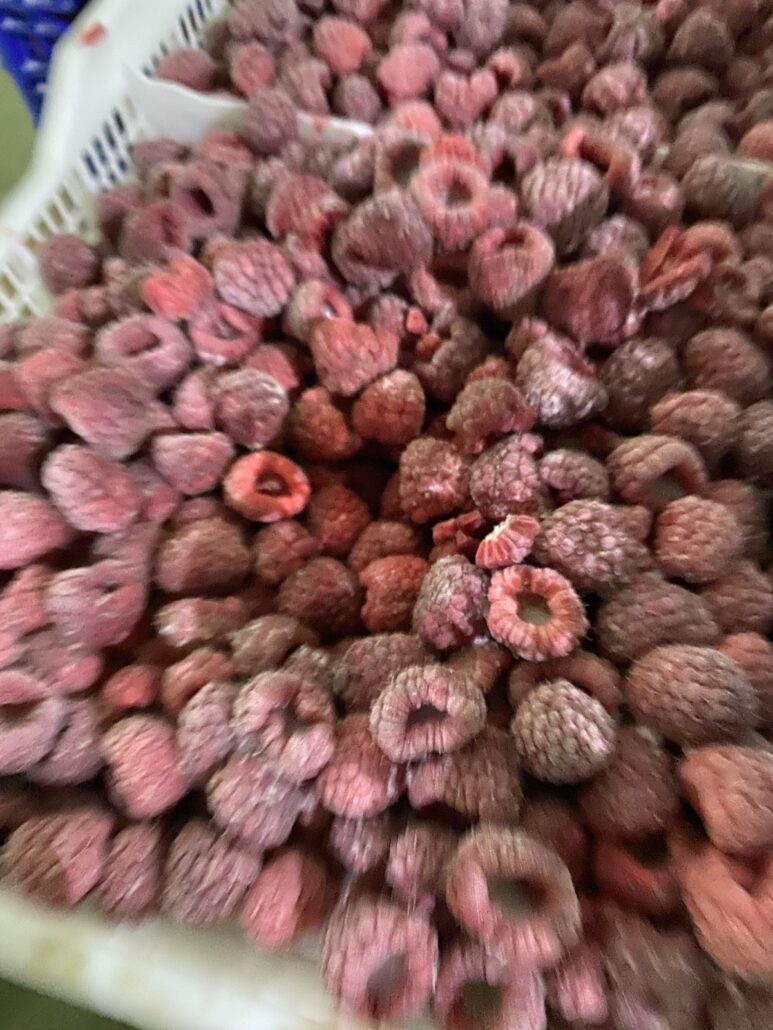Why does cold storage need to be disinfected?
The main source of biological contamination in cold storage is Geotrichum, which survives under low temperature conditions and has strong tolerance to disinfectants. Under the strong oxidation effect of ozone, all ungerminated spores including extremely resistant spores are killed. Practical application results also prove the excellent effect of ozone in cold storage disinfection.
Cold storage disinfection requires ozone concentration of 6-10ppm, bacterial killing rate of about 90%, and mold killing rate of about 80%.
Functional application principle of ozone generator for cold storage disinfection
The application of ozone in cold storage mainly has three aspects:
- Kill microorganisms – disinfection and sterilization;
- Oxidize various smelly inorganic or organic substances – deodorize;
- Oxidize metabolic products, thereby inhibiting the metabolic process.
- Kill microorganisms – disinfection and sterilization;
Although freezing may kill some bacteria, some pathogenic bacteria are extremely resistant to low temperatures and will “resuscitate” once the temperature rises. Especially in cooling rooms and cold storage rooms, because their temperatures are suitable for the growth of cryophilic bacteria, molds and yeasts, a large number of stored foods will be damaged. In this case, using a cold storage ozone generator will achieve satisfactory results. Ozone is a gas sterilizer, and its bacteriostatic and sterilizing effects are usually a comprehensive result of physical, chemical and biological aspects. Its mechanism of action can be summarized as the following three points: a. Acts on the cell membrane, causing the permeability of the cell membrane to increase, causing the outflow of intracellular materials, causing the cell to lose its vitality; b. Inactivating the enzymes necessary for cell activities. These enzymes can be either basic metabolic enzymes or extremely important enzymes for the synthesis of cells; c. Destroy the cytoplasmic human genetic material or cause it to lose its function. It is generally believed that ozone kills viruses by directly destroying their RNA (ribonucleic acid) or DNA (deoxyribonucleic acid) substances. While ozone kills bacteria and mold microorganisms, ozone first acts on the cell membrane, damaging the structure of the cell membrane, causing metabolic disorders and inhibiting their growth. Ozone continues to penetrate and destroy the tissue within the membrane until death.
② Oxidize various odorous inorganic or organic substances – deodorize;
The ozone produced by the cold storage ozone generator itself has a special smell. Using ozone to remove ozone does not use the smell of ozone to cover up other odors, but mainly uses the strong oxidizing ability of ozone. The main components of ozone smell are amine R3N, cyanogen sulfide H2S, methyl mercaptan CH3SH dimethyl sulfide CH3SCH3, dimethyl disulfide CH3-S-S-CH3, etc.
③Oxidizes metabolic products, thereby inhibiting metabolic processes.
During the storage of fruits and vegetables, ethylene is produced. It will affect other fruits and vegetables, causing them to mature further. This process begins with the skin turning brown, the flesh softening, and eventually rotting. Ozone can be used to oxidize ethylene into CO2 and water. While the ozone generator generates ozone, it also produces a large amount of negative ions. Negative ions also inhibit the metabolism of fruits and vegetables.
Specific application cases
Bananas: Bananas have a strong metabolism when ozone concentrations are high. However, at low concentrations, such as 33.21mg/m3 (1.5ppm), physiological damage may occur. If the ozone concentration is between 53.5~64.2mg/m3, black spots will appear on the banana skin after 8 days. In the range of ozone concentration of 64.2~192.6mg/m3 (30~90ppm), the respiration process accelerates, while the maturation process remains unchanged. The best conditions for using ozone to store bananas are a temperature of 12°C and a concentration of 3.21~3.64 mg/m3. Under these conditions, bananas do not mature quickly and their respiration intensity does not change much.
Citrus: Citrus is not sensitive to ozone, even at high concentrations of 85.6 mg/m3r. As ethylene and other metabolic products are oxidized by ozone, citrus ripening is slowed.
Berries: Mold colonies are particularly likely to develop during storage of strawberries, raspberries, and grapes.
This can use 4.28~6.42mg/m3 of ozone to inhibit the growth of mold without affecting the quality and aroma of berries, and the storage period can be doubled. However, the packaging method cannot prevent ozone from contacting the effect.
Apple: During storage, depending on the variety, biological damage will occur at ozone concentrations of 4.28~23.54mg/m3. Tests conducted in the United States have shown that most varieties are not damaged when refrigerated at 4.28mg/m3 for 5 months. If the concentration is slightly increased, the aroma of some varieties will be weakened and the quality will be somewhat reduced. Removing ethylene plays a significant role in extending storage life. Inactivation of metabolic products also reduces epidermal browning. According to a domestic unit, refrigerated apples kept fresh with ozone can still maintain their freshness half a month after leaving the warehouse.
Pears: Research on some special varieties of pears has shown that there is no deterioration or increase in respiratory intensity when stored for 17 days at an ozone concentration of 6.42 mg/m3 and a temperature of 5°C.
Treating vegetables with ozone has similar effects to fruits.。
Potatoes: The storage conditions are temperature 6~14℃ and relative humidity above 90%. Treating potatoes for 6 to 10 hours under ozone conditions of 15 to 18 mg/m3 can stop the growth of potato plagueberry colonies, but the color, taste, and density of the potatoes will not change. Under the action of ozone, the starch and vitamin C content of potatoes increase, and the sugar content decreases.
Garlic sprouts: In addition to temperature and temperature requirements, and gas composition control, the focus of ozone application in the storage of garlic sprouts is empty warehouse disinfection, storage pre-cooling sterilization and sterilization before and after ventilation. After the garlic sprouts are pre-cooled in storage, ozone with a concentration of 4.28~8.56mg/m3 can be used to kill some microorganisms on the surface of the garlic sprouts. For daily mildew prevention, ozone must be spread evenly, and the concentration should be such that it can effectively remove garlic sprouts gas without any obvious ozone smell. Mildew prevention of small bag packaging should be carried out before and after each ventilation. The main purpose of using ozone before ventilation is to reduce the microorganisms that enter the gas. After ventilation, ethylene oxide mainly removes odor. Ozone does not directly contact garlic sprouts, and the concentration can be appropriately higher. The arrangement of starting and stopping the ozone generator should be such that no obvious ozone smell can be smelled when opening the bag for ventilation. Practical applications have shown that ozone can strongly inhibit the expansion of decay zones. If rot occurs, direct exposure to ozone can give good results.
Tomatoes: For tomatoes used for storage, choose late-ripening varieties with thick, firm skins that mature between five and six. The layers are placed flat and controlled according to the temperature, humidity or air conditioning conditions. Empty warehouses need to be disinfected with ozone before entering the warehouse. For daily mildew prevention, use an ozone concentration of 8.56~10.7mg/m3 and start it every two days or once a day with an ozone concentration of 4.28~6.42mg/m3. When the concentration is reached, stop the ozone generator and store it for one and a half months. The good fruit rate is 80%~90%.
Bell peppers: Use scissors to cut off the stems when picking, as the stems are damaged and prone to rot. Bell peppers should be scattered in layers in the tent to facilitate contact with ozone and also facilitate the diffusion of CO2, ethylene, and heat. The general storage temperature is 12~15℃, and the temperature for autumn picking is 8~10℃, CO2 <3%, and O2 is about 10%. Ozone is charged 2 to 3 times a day in the first month, with a concentration of 10.7 mg/m3, and then 1 to 2 times a day. After 70 days of storage, the commercial rate of bell peppers reaches over 80%.
Eggs: By the end of 1930, 80% of the cold storages storing eggs in the United States were equipped with ozone generators, and achieved good results. There are two ways to utilize ozone in cold storage for storing eggs: continuous application and intermittent application. The continuously applied ozone concentration is 14.12mg/m3, the humidity is 90%, and the quality is very good after 8 months of storage. Most of my country’s current cold storages require personnel to enter the warehouse to check the temperature, so they use intermittent ozone supply. The method is to turn on the ozone generator 1 to 2 times a day with a concentration of 3.21 to 5.35 mg/m3. The start-up time should be staggered with the warehouse inspection time to facilitate personnel entry.
After each ozone sterilization, the number of bacteria in the air is reduced by about 70%, the number of molds is reduced by about 60%, and the number of bacteria and molds on egg shells is reduced by about 50%. At present, more than 30 egg cold storages in my country have applied ozone, and they have achieved good results, reduced losses, and achieved obvious economic benefits.
Meat: Ozone is mainly used for sterilization and preservation in the maturation and tenderization process of meat after slaughter. The method is to treat with ozone 1 to 2 times a day, each time lasting 2 hours. The ozone concentration is 6 mg/m3 (air), the temperature is 20°C, and the relative humidity is 85%. It can be maintained for 42 to 44 hours in a closed room. If the temperature is lowered to 6℃, it can be maintained for 10 days. When the ozone concentration is 10~20mg/m3 (air), the storage period of beef can be increased by 30%~40% compared with cooling alone. The microorganisms on the surface of beef do not exceed 103/cm3. Billou conducted detailed research on the storage period of beef, veal, mutton, pork, chicken and rabbit using ozone. Under normal circumstances, after 7 days of storage of various meats, it was found that the meat Clearly contaminated by microorganisms. Under the same circumstances, when ozone was used, microbial contamination did not appear until 14 days later. The general picture is that, under cooling, the surface microbial flora (Pseudomonas, spores, Salmonella, Staphylococcus) decreases with ozone compared to without ozone. If the level of contamination is already high, ozone will have no effect on the surface microbial flora. But it can still make the air in the cold storage feel fresh.
Cheese: Experience with the application of ozone during ripening and storage has been very successful. The temperature is 15℃, the relative humidity is 80%~85%, and the ozone concentration is 0.0428mg/m3. As a result, spores grow on its surface, which are killed during the ripening period, and the storage period is extended to 11 weeks. The trials were conducted on a British cheese. And the odor that exists in the storage room is also eliminated due to the oxidation of ozone.
Fresh fish preservation: Abroad, ice cubes made from water containing ozone are used to preserve fresh fish, which can extend the preservation by 50%. It is generally believed that ozone is relatively stable at 0°C and is not easy to decompose naturally. When ice containing ozone melts, ozone will be present in the ice-water mixture. It inhibits the growth of microorganisms, thereby extending the shelf life of fresh fish. The ozone generator produced by Longfa Environmental Protection Technology Co., Ltd. uses special processing at the front end. The ozone concentration and purity are higher, the service life is longer, and the effect is better. Please send the specific requirements of the project to china-ozone@ozone-factory. com, we will give you the most suitable advice based on your actual situation.

